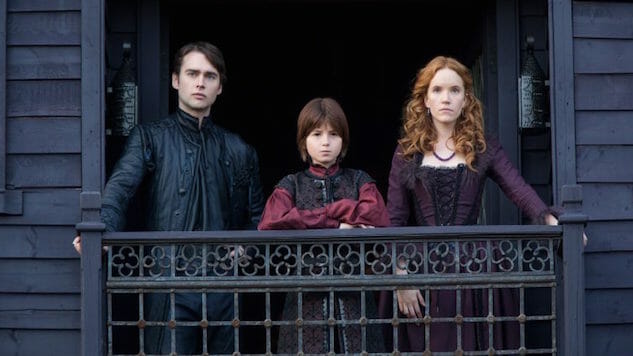With Penny Dreadful Gone, Salem Is the Gory, Empowering Alternate History We Deserve
WGN America
Salem, WGN’s first ever scripted TV show, has been going strong since 2014, offering up heavy gore alongside strong performances, breathing new life into the story of the Salem witch trials. While WGN has since gone on to greenlight an arguably more accomplished (read: “prestige”) show in Underground, Salem is certainly deserving of critical attention and weekly eyeballs. For all the pros and cons of “peak TV,” one of its more rewarding effects is the increased space being given to shows with a unique voice. In particular, genre shows seem to be growing in popularity, so much so that calling them “genre” shows, which implies some sort of niche appeal, doesn’t feel quite right.
While the popularity of, say, The Walking Dead might be an outlier of sorts, you don’t have to look very far to find more examples how of scripted television has found success by churning out genre shows and appealing to an audience hungry for something that embraces the tropes and style of genre filmmaking, fine-tuned for episodic television. From Cinemax’s pulpy, violent and surprisingly emotional Banshee, to Syfy’s slate of space assassins and feminist demon hunters in Killjoys and Wynonna Earp, to Showtime’s critical darling Penny Dreadful, if you have an interest in genre television, you have a bevy of options to choose from in 2016.
With Penny Dreadful leaving the air for good earlier this year, taking with it its 19th century Gothic feel and slew of great performances, there’s a gap in viewing that Salem deserves to fill. While there are plenty of horror shows to choose from while flipping through the channels, from the aforementioned The Walking Dead to the various iterations of American Horror Story and Robert Kirkman’s other ghastly cable show, Outcast, no series is as confident in its horror-indebted lunacy and thematic depth as Salem . Salem is everything you could want in a horror series: It doesn’t hold back when it comes to its gruesome images, and yet it balances out its bloody surface appeal with a depth in subtext, finding ways to use a familiar and overexposed story to subtly comment on issues related to gender, identity, and how history is shaped by those in a position to shape it.
The broad strokes of Salem will be familiar to anyone even vaguely familiar with the infamous witch trials. The key difference, of course, is that in Salem the witches are real, turning Cotton Mather’s proclamations about demons walking amongst the people into more than just the maniacal ramblings of a man easily prone to hysteria. But where The Walking Dead tends to dress up its pulpy story in the serious garb of prestige TV, Salem goes in a different direction. It leans into its ridiculousness, never once shying away from indulgent performances—casting Lucy Lawless in your show, be it Spartacus or Salem, is one way to assure your audience that your camp is going to be the best kind of camp—or from images that make you cringe before laughing with gruesome delight. In the first two seasons alone, a witch eats a man’s eyes and shoves a rat down her husband’s throat, while another scene sees a group of witches gather to chop off a man’s penis and replace it with a raven. For all its faults, Salem knows exactly what it is, flaunting its bold tone from one episode to the next.
With that said, delightfully gory horror and campy guest performances aren’t much of a reason for Penny Dreadful fans to tune into Salem. But much like Showtime’s monster mash, Salem’s true appeal is its attention to character work and the presence of mind to foreground some intriguing thematic explorations. Take the central conceit, for instance, which is that witches really do populate Salem in the 1600s. On the surface, it’s just a necessary gimmick to propel the show towards some intriguing narrative choices, creating conflict within Salem itself. Looking a bit deeper, though, it’s clear that having Salem literally populated by power-hungry witches does so much more.
What shifting the perspective does, first and foremost, is give some power back to the women in the story. The Salem witch trials were of course about women, but they were merely objects within a broader political and religious context. The accused and murdered women of the time were given no voice and no agency, and are often sidelined in historical retellings as well. In Salem though, the witches are the authority. They’re the ones calling the shots, even as men like Cotton Mather (Seth Gabel) and Little John (Oliver Bell), who’s understood to be the essence of Evil, believe they’re the ones in charge. This is the specific power of genre TV: It allows for the campy to be progressive and challenging as well. Our TV screens overflow with male antiheroes, and yet women rarely get to play similar roles—characters that are not only in charge, but also operate within a moral grey area. Mary Sibley (Janet Montgomery) is that character. She’s cruel and vindictive, but she’s also fighting for her life against a social structure that sent her true love, John Alden (Shane West), off to war, and seeks to oppress her and other women at every turn.
-

-

-

-

-

-

-

-

-

-

-

-

-

-

-

-

-

-

-

-

-

-

-

-

-

-

-

-

-

-

-

-

-

-

-

-

-

-

-

-








































